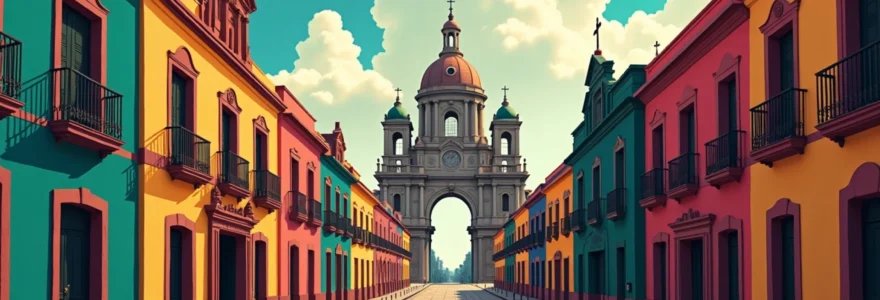Mexico City, a vibrant metropolis steeped in history and culture, offers an unparalleled blend of ancient traditions and modern innovations. From the remnants of the Aztec empire to world-class museums and culinary delights, this sprawling capital captivates visitors with its diverse attractions. Whether you’re a history buff, art enthusiast, or foodie, Mexico City’s rich tapestry of experiences promises to leave an indelible mark on your travel memories.
Exploring tenochtitlan’s legacy: zócalo and templo mayor
At the heart of Mexico City lies the Zócalo, a vast square that has been the pulsating centre of civic life since Aztec times. This historic plaza, officially known as Plaza de la Constitución, serves as a window into the city’s complex past and vibrant present. As you stand in this expansive space, you’re treading on the same ground where the Aztec empire once flourished, and where Spanish conquistadors later established their colonial rule.
Architectural marvels of the metropolitan cathedral
Dominating the northern edge of the Zócalo, the Metropolitan Cathedral stands as a testament to Mexico’s rich religious heritage. This architectural masterpiece, built over three centuries, showcases a harmonious blend of Baroque, Neo-Classical, and Neo-Renaissance styles. As you approach its ornate façade, you’ll be struck by the intricate stonework and towering bell towers that seem to touch the sky.
Step inside, and you’ll find yourself enveloped in a world of gilt altars, soaring vaulted ceilings, and priceless religious artefacts. The cathedral’s Altar of the Kings is particularly awe-inspiring, with its gold-leafed retablo rising 25 metres high. Don’t miss the opportunity to climb the bell towers for a panoramic view of the Zócalo and beyond, offering a unique perspective on the city’s layout and the juxtaposition of ancient and modern architecture.
Uncovering aztec ruins at templo mayor museum
Just a stone’s throw from the cathedral lies the Templo Mayor, the principal temple of the Aztec capital Tenochtitlan. Rediscovered in the 1970s, this archaeological site provides a fascinating glimpse into the pre-Hispanic world. The on-site museum houses an impressive collection of Aztec artefacts, including the famous Stone of Coyolxauhqui, a massive circular relief depicting the dismembered goddess of the moon.
As you explore the ruins and exhibits, you’ll gain a deeper understanding of Aztec cosmology, ritual practices, and daily life. The layered excavations reveal how successive Aztec rulers expanded and embellished the temple over time, each layer a chapter in the city’s pre-Columbian history. It’s a sobering reminder of the civilisation that thrived here before the Spanish conquest, and how its legacy continues to shape Mexican culture today.
Political significance of plaza de la constitución
The Zócalo isn’t just a historical site; it continues to play a crucial role in Mexico’s political and cultural life. This vast square has been the stage for countless protests, celebrations, and national events throughout the centuries. On any given day, you might encounter indigenous dancers performing ancient rituals, political demonstrations, or elaborate cultural festivals.
Flanking the eastern side of the plaza, the National Palace serves as a poignant symbol of Mexican governance. Its walls are adorned with Diego Rivera’s stunning murals, which offer a visual journey through Mexico’s history from pre-Columbian times to the mid-20th century. These vivid frescoes are not just works of art but powerful political statements, reflecting Rivera’s vision of Mexico’s past, present, and future.
The Zócalo is more than just a square; it’s the beating heart of Mexico City, where history, politics, and culture converge in a dynamic tapestry of urban life.
Artistic immersion: frida kahlo and diego rivera’s mexico city
Mexico City’s artistic legacy is inextricably linked to the lives and works of Frida Kahlo and Diego Rivera. These iconic figures of 20th-century art have left an indelible mark on the city’s cultural landscape, and their presence can be felt in numerous locations throughout the capital.
Casa azul: frida kahlo’s intimate world
In the charming neighbourhood of Coyoacán, you’ll find the Casa Azul, Frida Kahlo’s lifelong home and now a museum dedicated to her life and work. The vivid blue exterior is just a hint of the colourful world that awaits inside. As you wander through the rooms, you’ll gain intimate insights into Kahlo’s life, from her personal belongings and art supplies to her distinctive wardrobe.
The garden, lush with native Mexican plants, offers a tranquil space for reflection. It’s easy to imagine Kahlo finding inspiration among the cacti and pre-Hispanic sculptures that still adorn the courtyard. The studio, preserved as she left it, gives visitors a poignant glimpse into her creative process and the physical challenges she faced throughout her life.
Muralism at palacio nacional and bellas artes
Diego Rivera’s monumental murals can be found in several locations throughout Mexico City, but two sites stand out for their historical and artistic significance. At the National Palace, Rivera’s epic mural cycle The History of Mexico covers the walls of the main staircase and surrounding corridors. This vast work traces the sweep of Mexican history from pre-Columbian times to the post-revolutionary era, offering a visual narrative that is both educational and deeply moving.
The Palacio de Bellas Artes, with its stunning Art Nouveau exterior and Art Deco interior, houses some of Rivera’s most famous murals, including Man, Controller of the Universe . This controversial work, a recreation of a mural destroyed at Rockefeller Center, encapsulates Rivera’s political ideals and his vision of technological progress. The building itself is a work of art, with its marble interiors and Tiffany glass curtain in the main theatre.
Rivera’s Studio-Home in san ángel inn
For a more intimate look at Rivera’s life and work, visit his studio-home in San Ángel. This modernist structure, designed by Juan O’Gorman, consists of two separate buildings connected by a bridge – one for Rivera and one for Kahlo. The stark functionalism of the architecture contrasts beautifully with the vibrant colours and pre-Hispanic inspired details.
Inside Rivera’s studio, you’ll find an impressive collection of pre-Columbian artefacts, as well as some of his personal effects and unfinished works. The space offers a unique perspective on Rivera’s working methods and the sources of his inspiration. It’s a lesser-known gem that provides valuable context for understanding both Rivera’s art and his relationship with Kahlo.
Culinary adventures: tacos al pastor to haute mexican cuisine
Mexico City’s culinary scene is a gastronomic journey that ranges from humble street food to innovative haute cuisine. The city’s food culture is a reflection of its history, blending indigenous ingredients and techniques with influences from Spanish colonisation and modern global trends.
Street food hotspots: mercado de la merced and tianguis
To truly understand Mexico City’s food culture, one must dive into its vibrant street food scene. The Mercado de la Merced, the city’s largest traditional market, is a sensory overload of sights, sounds, and smells. Here, you can sample a wide array of Mexican street food classics, from tacos al pastor to tlacoyos and gorditas .
For a more localised experience, seek out the neighbourhood tianguis or street markets that pop up on different days across the city. These markets offer a glimpse into everyday Mexican life and are excellent spots to try regional specialities. Don’t miss the opportunity to taste esquites (corn kernels served in a cup with mayo, cheese, and chilli) or elotes (grilled corn on the cob with similar toppings).
Pujol: enrique olvera’s modern mexican gastronomy
At the other end of the culinary spectrum, Mexico City boasts several world-renowned restaurants that are redefining Mexican cuisine. Chief among these is Pujol, helmed by chef Enrique Olvera. Here, traditional Mexican ingredients and techniques are transformed into sophisticated, contemporary dishes that push the boundaries of culinary art.
Olvera’s signature Mole Madre, Mole Nuevo dish exemplifies his approach. It features a dollop of fresh mole alongside a streak of mole that has been aged for hundreds of days, creating a complex interplay of flavours that honours tradition while embracing innovation. The restaurant’s tasting menu is a journey through Mexico’s diverse culinary landscape, reimagined through a modern lens.
Pulque and mezcal: traditional spirits of mexico
No culinary exploration of Mexico City would be complete without sampling its traditional spirits. Pulque, an ancient fermented beverage made from agave sap, has experienced a revival in recent years. Visit a traditional pulquería to taste this milky, slightly viscous drink that comes in a variety of flavours.
Mezcal, tequila’s smokier cousin, has also gained popularity both in Mexico and internationally. Many bars in Mexico City offer mezcal tastings, where you can learn about the different varieties and production methods. The complexity and diversity of mezcal flavours might surprise you – from floral and fruity to intensely smoky.
Mexico City’s culinary scene is a testament to the country’s rich cultural heritage, offering a delicious journey from street corners to high-end restaurants that will satisfy even the most discerning palate.
Xochimilco’s floating gardens: UNESCO heritage site
South of Mexico City proper lies Xochimilco, a network of canals and artificial islands that offers a glimpse into the city’s pre-Hispanic past. This unique ecosystem, recognised as a UNESCO World Heritage site, played a crucial role in the agricultural system of the Aztec capital and continues to be an important cultural and ecological landmark.
Trajineras: navigating ancient aztec canals
The best way to experience Xochimilco is aboard a trajinera , a colourful flat-bottomed boat punted by a skilled remero (oarsman). These decorated vessels, adorned with floral patterns and often named after women, provide a leisurely way to explore the canals. As you glide along the waterways, you’ll encounter other boats selling food, drinks, and souvenirs, as well as floating mariachi bands offering serenades.
The atmosphere on weekends can be particularly festive, with locals and tourists alike enjoying picnics and parties on the boats. It’s a joyous celebration of Mexican culture, where you can savour local snacks, sip on micheladas (a spicy beer cocktail), and enjoy live music as you drift past the lush chinampas .
Chinampas: agricultural innovation of Pre-Hispanic mexico
The chinampas , or floating gardens, are perhaps the most fascinating aspect of Xochimilco. These artificial islands, created by piling up layers of vegetation, mud, and rocks, were an ingenious solution to the challenge of farming in a wetland environment. The Aztecs used this technique to expand their agricultural land and feed the growing population of Tenochtitlan.
Today, some chinampas are still used for agriculture, producing flowers, fruits, and vegetables using traditional methods. The intricate system of canals not only provides irrigation but also creates a unique ecosystem that supports a variety of plant and animal species, including the critically endangered axolotl, a salamander native to these waters.
Island of the dolls: xochimilco’s eerie attraction
For those seeking a more unusual experience, Xochimilco is home to the Isla de las Muñecas, or Island of the Dolls. This small chinampa is covered with dolls in various states of decay, hanging from trees and buildings. The island’s caretaker began hanging dolls to ward off evil spirits after finding a drowned girl in the canals. Over time, the practice grew, creating an eerie and surreal landscape that attracts curious visitors.
While the Island of the Dolls is not on the main tourist route and requires a special trip, it offers a unique and somewhat unsettling counterpoint to the generally festive atmosphere of Xochimilco. It’s a reminder of the complex blend of history, legend, and superstition that permeates Mexican culture.
Contemporary mexico city: polanco and roma norte
While Mexico City’s historical centre offers a journey through the past, neighbourhoods like Polanco and Roma Norte showcase the city’s modern face. These areas are hubs of contemporary culture, featuring cutting-edge architecture, trendy restaurants, and vibrant nightlife.
Museo soumaya: carlos slim’s architectural icon
In the upscale Polanco district, the Museo Soumaya stands out as a striking example of contemporary architecture. This private museum, funded by billionaire Carlos Slim, houses an extensive collection of European and Mexican art. The building itself, designed by Fernando Romero, is a sculptural marvel clad in 16,000 hexagonal aluminium tiles.
Inside, you’ll find works spanning from the 15th to the 20th centuries, including pieces by European masters like Rodin, Dalí, and Monet, as well as an impressive collection of Mexican art. The museum’s unique spiral structure guides visitors through six floors of exhibits, culminating in a top-floor space bathed in natural light. Best of all, admission to this world-class museum is free, making it accessible to all.
Hipster haven: boutiques and cafes of roma norte
Roma Norte, with its tree-lined streets and Art Nouveau architecture, has become Mexico City’s hippest neighbourhood. This area is a paradise for those seeking unique boutiques, artisanal coffee shops, and innovative restaurants. Stroll down Álvaro Obregón avenue to experience the heart of Roma’s creative energy.
For coffee enthusiasts, spots like Café Nin and Buna offer expertly crafted brews in stylish settings. Fashion lovers will appreciate boutiques like Carla Fernández, which showcases contemporary designs inspired by traditional Mexican textiles. As night falls, the neighbourhood comes alive with a diverse array of bars and restaurants, from mezcal specialists to innovative fusion eateries.
Chapultepec castle: panoramic views and royal history
Perched atop Chapultepec Hill, overlooking both Polanco and the historic centre, stands Chapultepec Castle. This former imperial residence now houses the National Museum of History and offers some of the best views of Mexico City. The castle’s checkered past includes serving as the home of Emperor Maximilian I and Empress Carlota in the 1860s, as well as being the site of a famous battle during the Mexican-American War.
As you explore the castle’s ornate rooms and lush gardens, you’ll gain insights into Mexico’s tumultuous 19th-century history. The murals by Mexican artists like Juan O’Gorman and David Alfaro Siqueiros add a powerful visual narrative to the historical exhibits. The castle’s location within Chapultepec Park, often called the “lungs of Mexico City,” makes it an ideal spot to combine cultural exploration with a breath of fresh air in the city’s largest green space.
Mexico City’s blend of ancient heritage and contemporary culture creates a unique urban tapestry that continues to evolve. From the remnants of Tenochtitlan to the avant-garde art scene, from street tacos to haute cuisine, the city offers a wealth of experiences that cater to every interest. As you explore its diverse neighbourhoods and attractions, you’ll discover that Mexico City is not just a destination, but a vibrant, living entity that captures the essence of Mexican identity in all its complexity and beauty.


